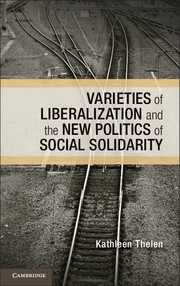Book contents
- Frontmatter
- Dedication
- Contents
- List of Figures
- List of Tables
- List of Abbreviations
- Preface
- 1 Varieties of Liberalization and the New Politics of Social Solidarity
- 2 Industrial Relations Institutions
- 3 Vocational Education and Training
- 4 Labor Market Policy
- 5 Coalitional Realignments and Institutional Change
- 6 The Future of Egalitarian Capitalism, in Light of Its Past
- Appendix A Components of Index and Descriptions of Variables for Figure 1.1
- Appendix B Components of Index for Figures 6.2 and 6.3
- Bibliography
- Index
- References
Bibliography
Published online by Cambridge University Press: 05 June 2014
- Frontmatter
- Dedication
- Contents
- List of Figures
- List of Tables
- List of Abbreviations
- Preface
- 1 Varieties of Liberalization and the New Politics of Social Solidarity
- 2 Industrial Relations Institutions
- 3 Vocational Education and Training
- 4 Labor Market Policy
- 5 Coalitional Realignments and Institutional Change
- 6 The Future of Egalitarian Capitalism, in Light of Its Past
- Appendix A Components of Index and Descriptions of Variables for Figure 1.1
- Appendix B Components of Index for Figures 6.2 and 6.3
- Bibliography
- Index
- References
- Type
- Chapter
- Information
- Publisher: Cambridge University PressPrint publication year: 2014

